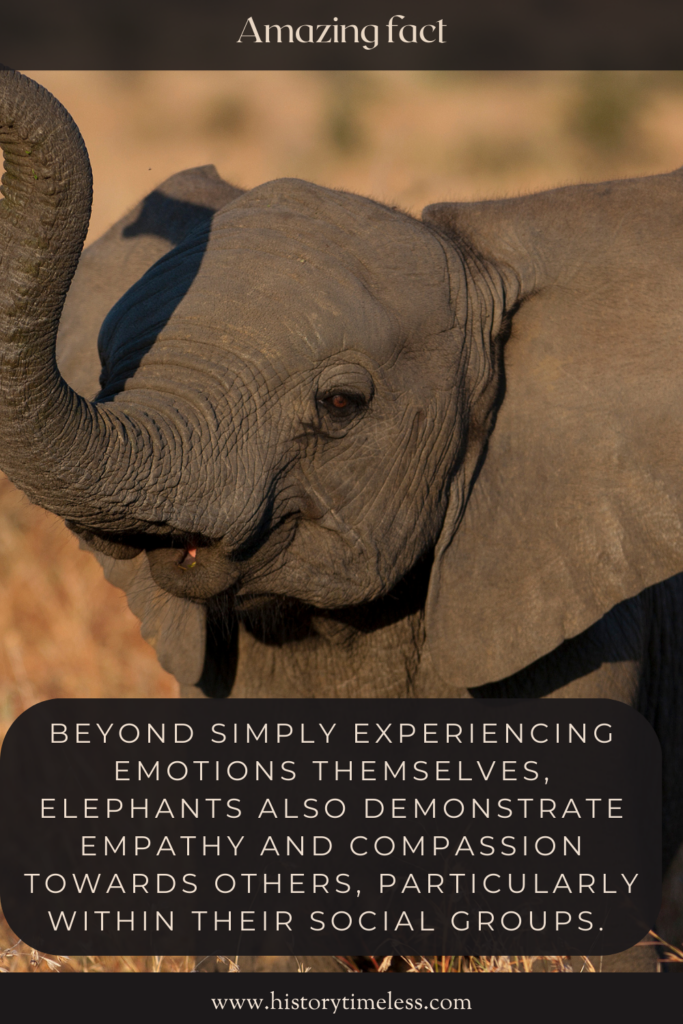Here are 25 fascinating facts about elephants, perfect for anyone intrigued by these gentle giants of the natural world. From their incredible intelligence and complex social lives to their unique physical attributes, elephants never cease to amaze.
Dive in to discover some truly captivating insights into the world of these magnificent creatures and expand your appreciation for their crucial role in our planet’s ecosystems. Prepare to be surprised and delighted by the sheer wonder of elephants!
1. Elephants Use Their Trunks for a Myriad of Tasks, Beyond Just Drinking
Elephants’ trunks are truly remarkable multi-tools, formed by the fusion of their nose and upper lip. This incredibly sensitive appendage contains over 40,000 muscles, granting it exceptional dexterity and strength.

Beyond drinking water, which they actually suck up and then squirt into their mouths, trunks are used for breathing, smelling, trumpeting, grasping objects, dusting, and even gentle caresses within their social groups.
They can pick up a single blade of grass or uproot a tree with equal ease, showcasing the trunk’s versatility and vital importance to an elephant’s survival.
2. Tusks Are Actually Elongated Incisor Teeth and Indicate Social Status
Those impressive tusks that define an elephant’s silhouette are not just for show; they are elongated incisor teeth made of ivory.
Both male and female African elephants typically have tusks, while only male Asian elephants usually possess them, and even then, some males and many females lack prominent tusks altogether.
Tusks grow throughout an elephant’s life, and their size and condition can indicate an elephant’s age, health, and social status within the herd.
Elephants use their tusks for digging for water and roots, stripping bark from trees, and defense against predators or rivals.
3. Elephant Skin, Though Thick, Is Surprisingly Sensitive to Sunburn and Insects
Elephant skin, appearing tough and leathery, can be up to an inch thick in some places. However, it’s surprisingly sensitive to both sunburn and insect bites.
To protect their skin, elephants engage in regular dust baths and mud wallowing. The mud and dust act as a natural sunscreen and insect repellent, creating a protective layer against the harsh African and Asian sun and pesky insects.
The characteristic wrinkles in their skin also play a role, helping to retain moisture and regulate body temperature, maximizing the cooling effect of mud and water.
4. Elephants Walk on Their Toes, Giving Them a Unique Footprint and Silent Stride
Despite their immense size and weight, elephants are surprisingly light-footed and can move relatively silently through their environment.
This is because they walk on their toes! What appears to be their “ankle” is actually their heel, raised high off the ground. Thick pads of fat and connective tissue cushion their feet, acting as shock absorbers and distributing their weight evenly.
This specialized foot structure not only allows for quiet movement but also helps them navigate diverse terrains, from soft sand to rocky ground, leaving behind distinctive, large, round footprints.
5. Their Enormous Ears Serve as Natural Air Conditioners to Regulate Body Temperature
Elephant ears are not just for hearing; they play a crucial role in thermoregulation, especially in hot climates. The large surface area of their ears is filled with a network of blood vessels.
By flapping their ears, elephants create a breeze and expose these blood vessels to the air, allowing heat to dissipate. This process, known as vasodilation, helps to cool their blood as it circulates through the ears, effectively lowering their body temperature.
On hot days, you will often see elephants flapping their ears vigorously to stay cool, acting like natural, biological air conditioners.
6. Elephants are Herbivores and Spend a Significant Portion of Their Day Eating
Elephants are herbivores, meaning their diet consists entirely of plants. To sustain their massive bodies, they need to consume a vast amount of vegetation daily, eating up to 150 kilograms (330 pounds) of food per day.
They spend approximately 12-18 hours each day foraging and eating, consuming grasses, leaves, bark, fruits, and roots.
This constant need for food and their foraging habits have a significant impact on their environment, shaping landscapes and influencing plant distribution through seed dispersal and vegetation management.
7. Water is Essential for Elephants, and They Can Drink Upwards of 50 Gallons a Day
Water is absolutely vital for elephant survival. They need to drink large quantities of water daily, sometimes up to 50 gallons (almost 200 liters) or more, especially in hot and dry climates.
Elephants use their trunks to suck up water and then spray it into their mouths. They also rely on water sources for bathing and mud wallowing, which, as mentioned earlier, helps with thermoregulation and skin protection.
The presence of elephants can actually indicate the location of water sources to other animals in the ecosystem, making them keystone species in their habitats.
8. Elephant Societies are Complex and Based on Strong Family Bonds Within Herds
Elephants are highly social animals, living in complex societies centered around family herds. These herds are typically composed of related females and their offspring, led by the oldest and often largest female, known as the matriarch.
These herds are not just random groupings; they are tightly knit family units where members cooperate in raising young, protecting each other, and sharing knowledge about resources and survival skills.
These bonds can last a lifetime, showcasing deep emotional connections and intricate social dynamics within elephant communities.
9. Matriarchs Lead Elephant Herds and Possess Crucial Knowledge for Survival
The matriarch, the elder female leader of an elephant herd, plays a vital role in the group’s survival and well-being. She is not just the oldest; she is the repository of the herd’s collective knowledge, accumulated over her long life.
Matriarchs guide the herd to water sources and food, make decisions about migration routes, and remember past experiences, such as locations of seasonal resources or dangers.
Their leadership is crucial, especially in times of drought or environmental change, as their wisdom and experience are essential for the herd’s continued success.
10. Elephants Communicate Through a Variety of Sounds, Including Low-Frequency Infrasound
Elephants are masters of communication, using a range of vocalizations, body language, and even seismic signals to interact with each other.
One of their most fascinating communication methods is infrasound – very low-frequency sounds below the range of human hearing.
These low-frequency rumbles can travel for miles, allowing elephants to communicate over long distances, especially in dense forests or across vast plains.
Infrasound is crucial for maintaining herd cohesion, coordinating movements, and even finding mates, showcasing a sophisticated and far-reaching communication network.
11. Elephants are Exceptionally Intelligent Animals, Exhibiting Problem-Solving Skills
Elephants are widely recognized as one of the most intelligent animal species on Earth. They possess large and complex brains, capable of sophisticated problem-solving, tool use (albeit limited), and self-recognition.
Studies have shown elephants can understand pointing gestures, cooperate in tasks, and even demonstrate an understanding of quantity and numbers.
Their intelligence is not just about cognitive abilities; it also manifests in their complex social interactions, emotional depth, and adaptability to changing environments.
12. They Possess Remarkable Memories, Remembering Watering Holes and Social Connections for Years
Elephant memory is legendary, and for good reason. They have exceptional long-term memories, which are crucial for their survival and social lives.
They remember migration routes, locations of watering holes, and past encounters with predators or other elephants, sometimes for decades.
This remarkable memory is especially vital for matriarchs, who use their accumulated knowledge to guide their herds through challenging environments and ensure their well-being.
Their ability to remember social connections also plays a role in maintaining herd cohesion and recognizing individuals within and outside their immediate family group.
13. Elephants Display a Wide Range of Emotions, Including Joy, Grief, and Compassion
Elephants are not just intelligent; they are also deeply emotional creatures. They exhibit a wide range of emotions that mirror human feelings, including joy, grief, anger, playfulness, and compassion.
They show signs of mourning their dead, often returning to the bones of deceased relatives and displaying behaviors that suggest grief.
They also exhibit empathy and compassion, helping injured or distressed individuals within their herd and showing concern for others in need, highlighting the depth and complexity of their emotional lives.
14. They Show Empathy and Compassion, Caring for Injured or Distressed Individuals
Beyond simply experiencing emotions themselves, elephants also demonstrate empathy and compassion towards others, particularly within their social groups.

They have been observed helping injured or sick elephants, using their trunks to lift them, offer support, or even bring them food and water. They display concern for distressed individuals, offering comforting touches and vocalizations.
This empathetic behavior underscores the strong social bonds and cooperative nature of elephant societies, where caring for others is an integral part of their community life.
15. Elephants Have a Long Lifespan, Living Up to 60-70 Years in the Wild
Elephants are among the longest-lived mammals, with a lifespan comparable to humans. In the wild, they can live for 60-70 years, and sometimes even longer in protected environments.
This long lifespan allows for the development of strong social bonds, the accumulation of knowledge, and the transfer of wisdom across generations within elephant herds.
Their extended life cycle also means that they have a slow reproductive rate, with females typically only giving birth every 3-4 years, making them particularly vulnerable to threats like poaching and habitat loss.
16. Elephant Calves are Raised Communally Within the Herd, Receiving Care from Many Females
Elephant calves are born into a nurturing and supportive environment within the herd. While mothers are primarily responsible for their calves, raising them is a communal effort.
Other females in the herd, often sisters, aunts, or other relatives, participate in caring for the young, providing protection, guidance, and even nursing them.
This “alloparenting” strengthens social bonds within the herd and ensures that calves receive constant care and attention, increasing their chances of survival and successful integration into the elephant society.
17. Elephants Sleep Standing Up for Most of Their Lives, Only Lying Down to Sleep Deeply
For most of their lives, adult elephants typically sleep standing up. This is likely an evolutionary adaptation to avoid predation and allow for quick responses to danger.
Standing sleep is usually short and light, allowing them to rest without fully relaxing. However, elephants do lie down to sleep for deeper, REM sleep, especially when they are young or feel secure.
Lying down allows for full muscle relaxation and is necessary for restorative sleep, but it is less frequent in adult elephants in the wild.
18. Elephants are Excellent Swimmers and Can Use Their Trunks as Snorkels
Despite their massive size, elephants are surprisingly adept swimmers. They are naturally buoyant and can easily navigate rivers and lakes.
When swimming in deeper water, they use their trunks as snorkels, extending them above the surface to breathe while their bodies are submerged.
Swimming not only helps them cross water bodies but also provides a way to cool down and play, showcasing their adaptability and enjoyment of aquatic environments.
19. Beyond Trumpeting, Elephants Make a Variety of Vocalizations to Express Themselves
While the iconic elephant trumpet is well-known, elephants actually communicate through a wide range of vocalizations beyond just trumpeting.
They use rumbles, roars, cries, and snorts, each carrying different meanings and conveying various emotions or intentions.
These vocalizations, combined with body language and infrasound communication, create a rich and nuanced language that allows elephants to interact effectively within their complex social structures.
20. An Elephant’s Sense of Smell is Their Most Acute Sense, More Powerful Than Sight or Hearing
Among their senses, an elephant’s sense of smell is considered their most acute and powerful. They rely heavily on their trunk to sniff out water sources, food, and even detect predators or other elephants from long distances.
Their olfactory bulb, the part of the brain responsible for smell, is significantly larger than in humans, indicating a highly developed sense of smell that plays a crucial role in their navigation, foraging, and social interactions.
21. While Not as Sharp as Smell, Elephant Hearing is Also Excellent, Detecting Sounds from Miles Away
While their sense of smell is paramount, elephants also possess excellent hearing. Their large ears are not just for thermoregulation; they are also highly effective at collecting sound waves.
Elephants can detect a wide range of frequencies, including infrasound, and can hear sounds from miles away, allowing them to be aware of their surroundings and communicate over long distances.
Their hearing complements their other senses, providing crucial information about their environment and social landscape.
22. Elephants Have the Largest Brains of Any Land Animal, Reflecting Their High Intelligence
Elephants boast the largest brains of any land animal, though in proportion to their body size, their brain size is similar to other primates.
However, the sheer size and complexity of their brains are indicative of their high intelligence, complex social behaviors, and cognitive abilities.
Their brains are highly convoluted, with a well-developed neocortex, the area associated with higher-level thinking, problem-solving, and emotional processing, further supporting the evidence of their remarkable intelligence.
23. Elephants Play a Vital Role in Their Ecosystems, Acting as “Ecosystem Engineers”
Elephants are considered “ecosystem engineers” due to their significant impact on shaping their environments.
Their feeding habits, such as breaking branches, uprooting trees, and digging for water, create pathways through dense vegetation, open up forests, and create waterholes that benefit a multitude of other species.
They are also crucial for seed dispersal, as they consume fruits and seeds and deposit them in their dung across wide areas, contributing to plant diversity and ecosystem health.
24. Both African and Asian Elephant Populations are Facing Significant Threats, Primarily Habitat Loss and Poaching
Sadly, both African and Asian elephant populations are facing severe threats, leading to their classification as endangered or vulnerable species.
Habitat loss due to human encroachment, agriculture, and infrastructure development is a major issue, reducing their living space and access to resources.
Poaching for their ivory tusks remains a persistent and devastating threat, decimating populations for the illegal ivory trade. Conservation efforts are crucial to protect these magnificent animals and their vital roles in their ecosystems.
25. Elephants Exhibit Playful Behavior Throughout Their Lives, Especially Young Elephants
Elephants are not just serious and majestic; they also have a playful side, particularly evident in young elephants. Calves engage in playful activities like chasing each other, mock fighting, playing with objects, and splashing in water.
This playful behavior is not just for fun; it’s crucial for their social development, physical coordination, and learning about their environment.
Even adult elephants can exhibit playful behavior, demonstrating their continued curiosity and capacity for joy throughout their long lives.
Find out some surprising truths:
26 Weird Facts Random, You’ll Think We Made Them Up!
25 Funny Weird Facts That Will Make You Go “Wait, What?!”
20+ Insane Facts About Animals That Defy Belief!
15+ Interesting World Facts: Say ‘Wow’ to These Discoveries!





